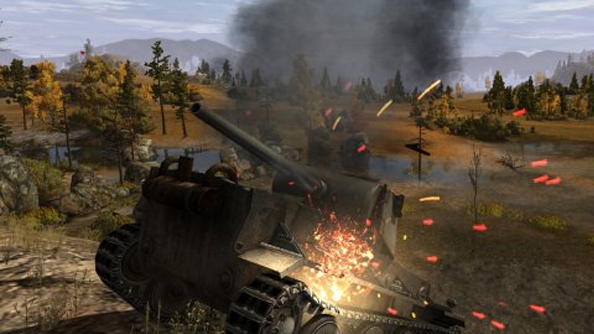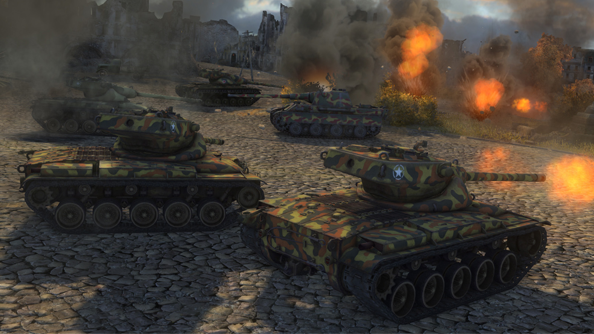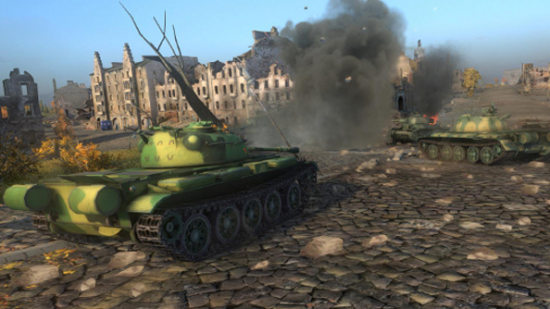I’m watching the Grand Finals of World of Tanks’ largest tournament, the WGL. This should be the most exciting bit: a chance to see trained, professional tank commanders battling it out, a chance for heroism and tactics and drama.
But it’s boring. Of the five games between the finalists, three have ended in draws. In the two hours of games there’s only about ten minutes of actual action. The teams are playing cautiously, each player sheltering behind cover, keenly aware a single shell could take them out of the game, leaving their team mates at a disadvantage that could mean missing their collective shot at the $60,000 prize pot.
In professional World of Tanks, camping is simply too sensible a strategy.
Wargaming think they have a fix. It involves explosions.
World of Tanks wasn’t conceived as a esport. It was built to support two teams of 15 players working to eliminate the enemy. Its levels are large, its tanks have long health bars, and they move slowly. In the World of Tanks games you or I will play online, cautious play is rewarded, and rewarding. With 30 tanks on the field, it doesn’t take long for players’ nerves to shatter – and an opponent rushing into your gun sights.
Games are won by either destroying all the tanks on the enemy team or by capturing their base. If the round’s ten minute timer reaches zero but both teams have tanks on the field and retain control of their base then the game ends in a draw.
The esport Wargaming.net want to create is hobbled by the game’s rules.
In the esport version of World of Tanks, teams are made up of only seven players, less than half the number the game’s designed for. These players have trained together and, if they’ve made it to the grand final, know how to hold the line. That leads to a stale set of strategies: in the opening phase of the game both teams rush to good positions and then wait.

Every hill and bush becomes a potential ambush. Players choose to wait instead of advancing. With a ten minute timer on each match they can wait until the last two minutes of a round before making a move. Why two minutes? If your team mounts an assault on the enemy base and it goes south then you simply run away, hoping to keep one of your team alive long enough for the round timer to reach zero, causing the game to end in a draw.
You can see an example of this from the WGL Finals. In the second round Na’Vi were playing against Virtus Pro on a map called Ensk. Leaving it till 1.40 on the clock Na’vi attacked Virtus’ base, Virtus pushed them back and Na’Vi managed to run one of their tanks to the maps northwest corner to end the game in a draw. Prior to that assault was eight minutes of camping, which is slightly more entertaining than watching a fly clean itself.
Elimination rules don’t help. There are no respawns in World of Tanks. Like Counter-Strike, once you’re dead you’re out of the game. If you’re playing the main game that’s not much of a problem, you go back to your garage, select another tank and hop into a game. In a tournament with money on the line it could see your team lose their shot at $60,000. Taking risks costs.
Even World of Tanks’ line-of-sight system causes issues. Your enemy doesn’t appear on the mini map unless one of your team can see them. On maps that are full of buildings and visual obstructions tanks can hide from the enemy all too well, lying in wait to ambush you. This puts players off moving from their safe spots because around the corner of every street could be a string of T-32s.
That’s what happened to Na’vi in fourth round of the finals.
With 80 seconds left of the game Virtus made a push up the streets of Himmelsdorf unseen by the Na’vi scout. It was a well played advance but badly timed. They just didn’t have enough seconds on the clock to take out Na’vi. The match ended in a draw. Again.
“We’re aware that teams camp in our game as a strategy,” Mohamed Fadl, Wargaming’s head of eSports, tells me. Wargaming hope to fix it with World of Tanks 9.1 update. “We’re getting to the point where everything is destructible. It changes the whole strategy for teams, they can’t hide behind things.”
Wargaming have shown off the destruction tech in what may be the only physics demonstration inspired by Freud:
“The destructive places that you can get through and see through are going to change the meta for the game,” Frédéric Menou, Wargaming’s managing director for EMEA and North America, explained. “We are seeing today that players are taking positions that they could not have taken before and it’s going to be the same again.”
He’s talking about the changes to the physics engine that Wargaming introduced in the last year’s updates. They allowed tanks to move at steeper angles and drive through shallow water. Throughout the finals teams exploited these changes to attack their enemies in unexpected ways, driving up slopes at odd angles to flank them from behind.
But they also used those same physics to camp better – scouts would hide in shallow water to wait out the end of the game in search of a draw.
It’s the next round of updates that will change things for the better. The ability to blast holes in most of the game’s buildings will severely reduce camping. If you’re worried an enemy tank is behind a building you can now just blow it up to check.
It’s should radically alter how World of Tanks plays. We’re going to see teams building upon the earlier features of line of sight and elimination to herd their opponents into traps. By destroying cover a defender will have to keep moving to stay out of the sights of their enemies’ guns. An attacker can force defenders to abandon their positions. A good team should know where to strike to open a channel to the defenders’ base while also maintaining enough cover to make their advance.
It should mean that from minute one tanks will be advancing, catching each other off guard, and, most importantly, getting kills.
Wargaming have other methods up their sleeves, too, besides fireworks.

“We’re making smaller maps,” Fadl explains. Maps just for tournament play. They’re also supporting smaller teams. “Players are asking for 3v3 in a lot of the smaller community tournaments. We have thousands of players participating in 3v3.”
3v3 games are faster, finishing in a couple of minutes, and require new team dynamics. In a 7v7 game the teams are usually composed of two scouts and five heavy tanks. The heavies sit back and wait for the scouts to spot the enemy. In 3v3 the heavies have to be on the move. Without the numbers of a 7v7, they can’t create a full defensive line. Camping just leaves you exposed to flanking.
Wargaming will even change the rules to encourage aggression. “One of things we did, for two reasons, is compensating teams for a win,” says Menou. “Even if you lose in all the brackets but you did 2-1, so you won one match, then you’re going to get money, so it’s pushing players not to draw but to win.”
That incentive worked, at least in the early games of the tournament. In a match between Lemming Train and Synergy we saw some really aggressive play, with games finishing in five rather than ten minutes. It also led to some unexpected tactics. Lemming Train’s Ealien sprinted across the open plain while being fired on by all of the opposing team, every one of their shells missing as they were blindsided by his unconventional maneuver.
Those incentives carried less weight later in the tournament as the teams reached closer to the grand prize but it made for a more exciting start.
I’m not bored anymore. This time next year, when I’m sat watching the second WGL Grand Finals I expect my eyes to be glued to the screen.
